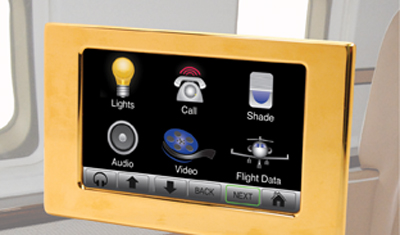
News
Taking the office aloft
There was a time when cabin management systems (CMS) in business aircraft were utilitarian and unremarkable. Using electro-mechanical relays and switches, CMS controlled the cabin temperature and lighting, and that was about it.
February 5, 2010 By James Careless
There was a time when cabin management systems (CMS) in business aircraft were utilitarian and unremarkable. Using electro-mechanical relays and switches, CMS controlled the cabin temperature and lighting, and that was about it.
 |
That was then; this is now. Today, a typical business aviation CMS supports in-cabin audio and video, plus satellite-connected voice, text, fax, TV, radio and Internet traffic, in the cabin and cockpit. And that’s not all: “Flight Display Systems [a business aviation CMS integrator] receives many requests for things such as Blu-ray players, iPod docking stations to allow for audio and video integration, and worldwide Moving Map displays,” says Nick Gray, the company’s international marketing manager.
“Today’s business aircraft CMS is akin to a high-end home entertainment system in the sky,” says Paul Lafata, Honeywell’s CMS business leader. “Customers want HD displays in various locations, Blu-ray players, satellite radio and television, Surround Sound – everything they can get in their living room or sports car.”
Businesspeople who spend a lot of time in the sky want to bring their offices aloft. As a result, their CMS systems have to support the full range of voice and data applications they rely on, plus real-time videoconferencing. “Today’s businessperson wants to be able to hold virtual meetings wherever they are,” says Lafata. “So we have to integrate installation of monitors and two-way communications to support high bandwidth videoconferencing and interactive multimedia.”
How it works
Today’s business aviation CMS is IP-based. In other words, the various features are all connected by wire and wireless Ethernet to a cabin interface unit. These features include HD monitors, DVD and Blu-ray players, audio amplifiers, speakers, 3-D HD moving maps, video cameras and microphones, fax machines, iPod/iPhone/BlackBerry docks, telephones, lights, heating and A/C units, custom user control interfaces, and remote controls. The cabin interface unit, or CIU, can be mounted virtually anywhere, which adds to ease of installation. The system is accessible for programming or diagnostics by qualified technicians, but kept safely out of the passengers’ reach.
 |
|
| With Flight Display Systems Select CMS, passengers can access HDTV video, audio, window shades, lighting, temperature, and many more cabin amenities – all by using a simple touchscreen interface.
|
By using this approach, CMS installers can keep cabin disruption to a minimum. New devices are simply installed where required, with Ethernet cabling being run through existing conduits (wherever possible). “We don’t want our customers to have to tear the aircraft apart every time they add something new,” says Paul Lafata. “Granted, adding monitor mounts and HD monitor lifts can require extra modifications to the cabin, but we do our best to minimize this wherever we can.”
Challenges
Business aviation CMS vendors face a few key challenges in making their customers happy. The first challenge is space; even with today’s IP-based equipment and miniaturized electronics, CMS installers still have to contend with the limited space available in aircraft. There’s only so much room to run wires and install equipment, particularly in older aircraft that were built before the Internet and HDTV existed.
Power is another issue: all of this entertainment and computer equipment requires electricity to function. To support this, an aircraft must either have some available power to spare from its existing systems or incorporate some new form of power generation system that, in turn, will eat up precious fuel when running.
CMS-supported technology must always take a back seat to avionics. There must never be an opportunity for this technology to interfere with the aircraft’s control systems. This is where wireless systems can be a cause for concern.
“Finally, CMS must also support equipment upgrades,” says Lafata. “Things change, and customers want to keep up. We have to ensure that any CMS we install is both future-proof and scalable, in that it can support additional devices being added over time.”
Looking ahead
As consumer and business technology continues to advance, so too will the capabilities and demands on business aviation CMS. This is why companies such as Flight Display Systems are looking ahead. In the near future, “We hope to add new features such as Video-on-Demand and iPhone integration,” says Nick Gray.
In fact, the only limits to CMS evolution will be those associated with aircraft themselves; namely the space for such equipment to be fit, the cabling to connect it and the power to keep it running. Beyond this, only time will tell how much earthbound technology can be added to aircraft cabins!
| A look at what CMS vendors are offering
Flight Display Systems At NBAA 2009, Flight Display Systems unveiled its new Select CMS. With Select CMS, passengers can access HDTV video, audio, window shades, lighting, temperature, and many more cabin amenities – all by using a simple touchscreen interface. One nice point: The Select CMS is a retrofit CMS (it can be added to older aircraft) that comes with an HDTV backbone capable of transmitting Blu-ray movies to the cabin’s TV screens. “Select CMS was designed with a focus on retrofit projects,” says Nick Gray. “Our target market is the aircraft with a cabin interior that needs upgrades in technology, carpet and seats. We use the latest technology to give passengers multiple channels of high definition video and life-like audio.” Details can be found at www.flightdisplay.com. Honeywell Aerospace Products The Ovation Select Series is an all-digital business jet cabin management solution. It is an extremely flexible and lightweight system, designed for easy installation in either the factory or the hangar. The Ovation Select Series provides complete digital distribution of command and control data, entertainment audio and video sources, computer, power and network data using a gigabyte Ethernet backbone. This is the same kind of Ethernet backbone used in modern offices, offering lots of headroom for expansion down the road. Meanwhile, Honeywell continues to support and expand its Ovation C-Series CMS. The new C-Series Cup Holder allows passengers to charge and use their iPod from any equipped cup holder on the aircraft. Meanwhile, the C-Series Select 200C Passenger Control Unit allows a passenger to control lighting, temperature and entertainment from the comfort of his or her seat. Visit www51.honeywell.com/aero for more information. Panasonic Avionics Corporation Rockwell Collins |